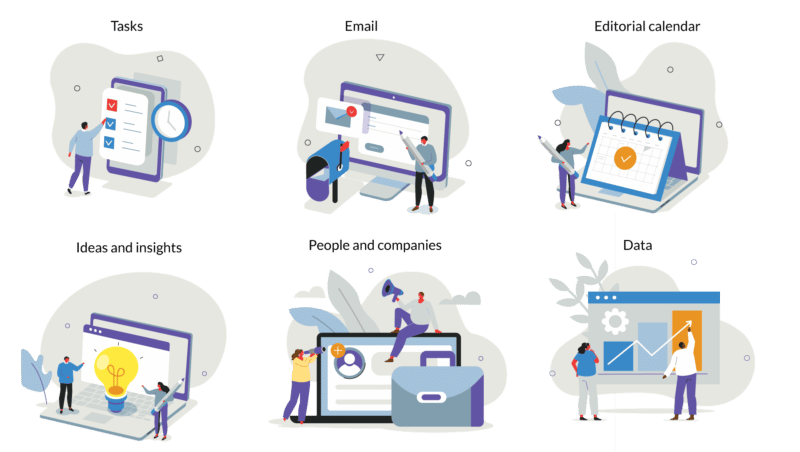

While I’m not technically a content marketer, the workflows I’ve developed as a journalist and researcher can benefit anyone creating content in our diverse, information-rich environment. In this article, I’ll explain my philosophy and share the elements that are working for me, with the aim of sparking ideas that benefit your content marketing program and, by extension, the audience you’re trying to reach.
First, let me take a step back and explain a term I used in the headline: Knowledge management. I remember back in high school learning about how the U.S. economy was becoming driven by information. As a budding writer, it instantly made sense to me — I was going to be a “knowledge worker.” What wasn’t so clear back then was how complex this task of knowledge management was going to be. Instead of going to a library and furiously documenting book-borne facts on notecards, today, the information is everywhere.
The knowledge juggling act

I have ADHD, so this issue may be more intense for me than for others, but do you ever find yourself lying in bed at night going through a mental list of things you’re afraid of forgetting? It’s like you’re juggling dozens of bits of information in the foreground of your mind, which is preventing you from doing the important job of recharging your brain with a good night’s sleep.
Taming the beast
The goal of knowledge management, in my view, is taming all of the important information coming at you — emails, newsletters, trade publications, webinars, events and even conversations — so it’s available when you need it, and only when you need it. For content marketers, some of the things you might want to manage include:
- Article ideas.
- Points you want to make in upcoming articles.
- People you want to interview or otherwise tap for their wisdom (such as asking a colleague to do a blog post for your company’s site).
- Research material, including writing by others as well as data.
- Your editorial calendar and the status of content in production.
A few factors make this challenging. First is the fact that different types of information are optimally stored in different ways. An editorial calendar might be best captured on, say, a calendar application, or something organized in a temporal order. Information about people and companies lends itself to a CRM-type organizational scheme, with multiple contacts per company. Content status might call for a checklist or other task-management application. Data might be best stored and analyzed in a spreadsheet.

And then there’s everything else — web content you read that sparks ideas, a white paper you download that makes an important point you want to cite, a great infographic or data visualization whose structure would apply perfectly to something you want to express, a Twitter thread that captures the zeitgeist better than you ever could by yourself. I’m sure you get the idea. And I haven’t even mentioned email.
I’ve struggled with this for years and tried just about every productivity tool you can imagine, but, recently, perhaps because of advances in machine learning and artificial intelligence, things in my world are starting to take shape. The principles guiding my knowledge management these days include:
- Use as few tools as you can. Switching contexts and cutting and pasting are time sucks, plus they increase the risks of introducing errors. Given that guideline…
- Get as close as you can to a “best-of-breed” solution for your use case. It just doesn’t make sense to store contacts in a Google Document or use a spreadsheet for things that can’t be sorted and filtered. You’ve got to be able to use the information you’re collecting. The key to making best-of-breed work is that…
- Everything must connect as seamlessly as possible.
Here’s how I do it

Over many free trials and proofs of concept, I’m settling into a few tools that I’ll describe to you below. I’ll start with connectivity here because it’s the most important element. With the ubiquity of APIs, connectivity should be a given. But not all integrations are created equal — the way an API is set up can make a difference between seamless synchronization and endless frustration.
- For connecting things: Zapier. I’m not a coder, though I’m teaching myself how to use Webhooks and APIs with the much-needed help of Zapier. Typically, though, the built-in triggers and actions work just fine for most purposes. Honestly, I don’t know what I’d do without a tool like this. Zapier integrates with all the other tools and allows you to achieve the “flow” part of workflow.
- For task management and timelines: ClickUp. While primarily a task management app, the company seems to aspire to be everything to everyone (with uneven results, thus far). The task management elements are fantastic and I love the flexibility and design of the interface — the usefulness of color coding cannot be overestimated.
- For people and companies: Airtable and Noloco. Because my primary responsibility is to create our company’s MarTech Intelligence Reports, I gather a lot of data about marketing technology vendors, and, of course, the contacts at those companies are key. I’ve used ClickUp for tracking people and companies, but it’s clunky — it’s just not made to do that. The best combination I’ve hit on thus far is using Airtable to store and establish connections between different tables of data and Noloco to set up displays customized to individual users. I could share my whole Airtable with our sales team, but then their eyes would glaze over and they’d never find the information they need. Two observations: Airtable is trying to develop better views through its Interfaces beta functionality, but it isn’t quite there yet, in my opinion. And Noloco also works (in beta) with Google Sheets, though it’s very awkward at the moment. All this to say that I’d love to make this one tool rather than two, but nothing I’ve found seems to do everything I need in this area.
- For gathering structured data: JotForm. Yes, there are better-looking form applications, but JotForm is incredibly flexible (offering conditional logic, direct integrations with lots of things, pre-filling, etc.) as well as CSS control of look-and-feel. I even use it internally when I’m gathering structured data like information that eventually goes into Airtable or ClickUp.
- For unstructured data: Mem. This one could be an article in itself (and it probably will be, in the future), but, for me, Mem is where I dump “everything else” — emails, bookmarks, scrapes of web content, notes and transcripts from meetings and virtual events, etc. Eschewing the folder structure that made Evernote a non-starter for me, Mem connects your entries via hashtags and, now, the recently-debuted Memex artificial intelligence capability. The idea is that you are writing or looking at something in the main window of the tool, and Mem automatically surfaces everything that’s related in the right sidebar, making it easy to find “that thing I saw last month” that relates to the project I’m working on now.
There’s so much more to say, and in the coming weeks and months, I’ll continue to explore these personal-level technologies that can boost your productivity as a marketer. Stay tuned for deeper dives into the subjects I’ve touched on here, including specific examples of workflows that make a difference.





